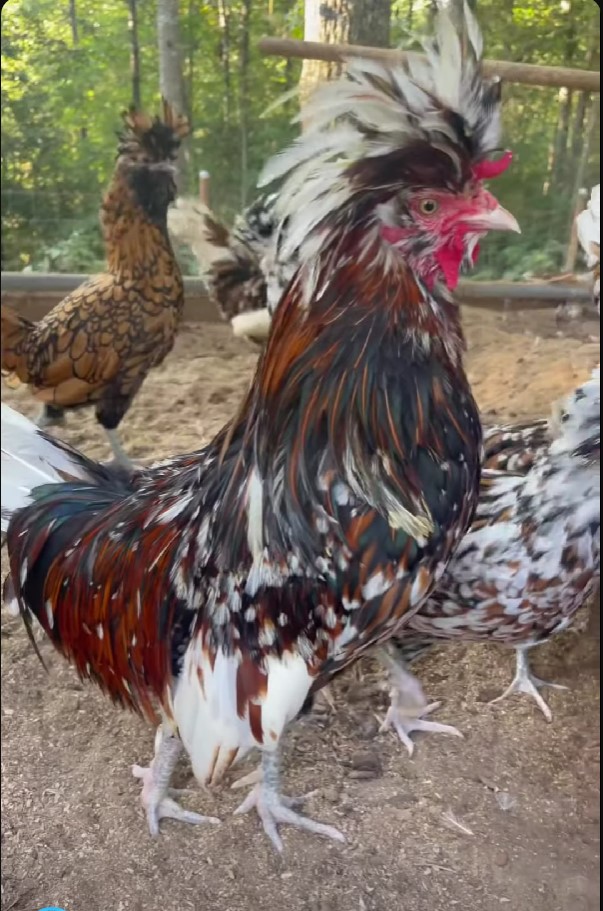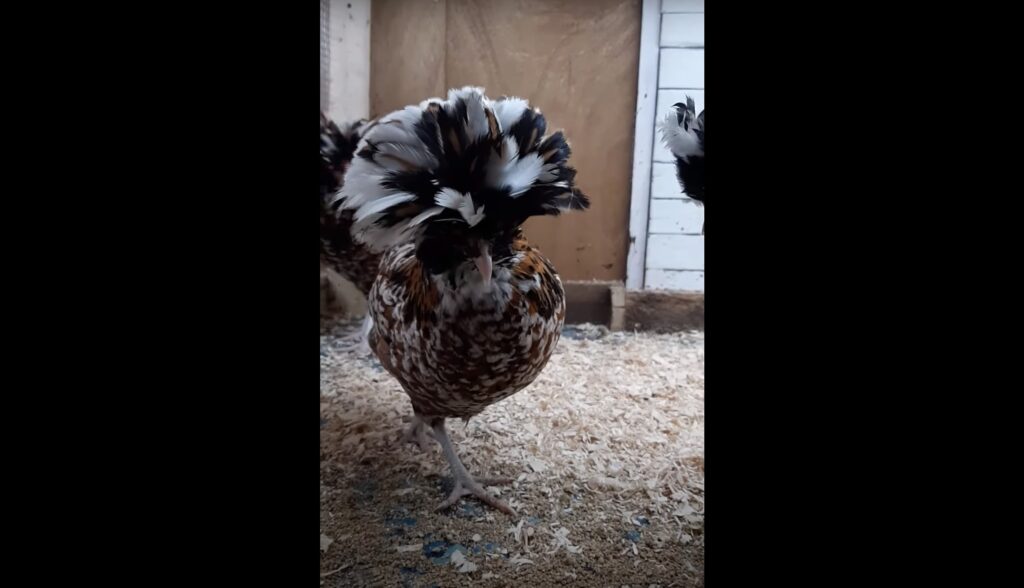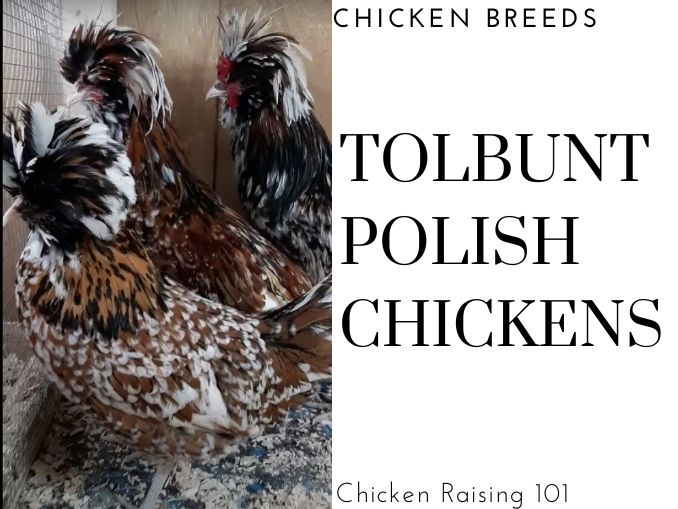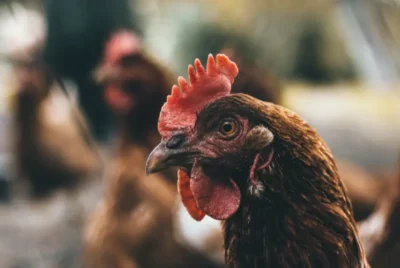Tolbunt Polish Chickens: Understanding the Basics Before You Buy
Before buying Tolbunt Polish Chickens, it’s important to know they can be tricky to take care of. They have big, fancy feathers that look cool but make it hard to see predators, so you must keep them safe. They also need a special diet and might get stressed by changes in their home.
Let’s get into the basics to help you prepare.
Physical Characteristics
- Color and Pattern: The Tolbunt coloration is unique, featuring a mix of white, black, and brown in a laced mottled pattern. This tricolor effect is both striking and highly sought after among poultry enthusiasts. The Tolbunt pattern is not recognized in all countries’ poultry standards but is celebrated for its beauty by breeders and enthusiasts worldwide.
- Feathers and Crest: Like other Polish chickens, the Tolbunt Polish has a large, fluffy crest of feathers on its head. This crest can sometimes impede their vision, giving them a somewhat comical demeanor. Their feathers are soft and abundant, contributing to their distinctive silhouette.
- Size and Body Shape: Tolbunt Polish chickens are relatively small to medium, with hens weighing around 3 pounds and roosters weighing slightly more, typically 6 to 6.5 pounds. They have a slim, upright body shape, which, along with their feathered legs, gives them an elegant appearance.
- Beak, Eyes, and Legs: They have a short, curved beak, and their eyes are often partially obscured by their crest. The legs are clean of feathers (in contrast to some other breeds) and are slate blue or gray.
Read also: Gold Polish Chicken Breed: Adding Brilliance to Your Flock
Housing and Environment Needs
Tolbunt Polish chickens, with their distinctive looks and crested heads, require thoughtful care to thrive. They need spacious, well-ventilated coops that protect them from predators, given their limited vision due to their elaborate feathers.
About 10 square feet of space per bird is ideal, along with nesting boxes for laying hens and varied-height perches for roosting. Their housing must be secure yet provide proper air circulation without direct drafts.
Moreover, a balanced diet, fresh water, and regular health checks are crucial, especially for monitoring any issues hidden beneath their unique plumage. These chickens benefit from dust bathing areas for feather and skin health, and while they adapt to different climates, they need protection from extreme weather.
Lastly, feather care, including occasional trimming for visibility and cleanliness and attention to their social dynamics to prevent bullying, are also important. Providing for their specific needs ensures these ornamental birds live healthily and happily.
Egg Laying Capacity and Egg Characteristics
Tolbunt Polish chickens, while primarily kept for their unique and ornamental appearance, do lay eggs, though they are not considered high-volume producers compared to more traditional egg-laying breeds. You can expect a Tolbunt Polish hen to lay about 100 to 200 eggs per year. This can differ depending on diet, environment, and overall health.
The eggs of Tolbunt Polish chickens are typically small to medium in size and are usually white, though some may have a slight tint depending on the individual hen. The shell quality is generally good, making them suitable for standard culinary uses.

How to Find Reputable Breeders for Tolbunt Polish Chickens
- Poultry Clubs and Associations: Start by contacting national and regional poultry clubs and associations focusing on Polish chickens or heritage and rare breeds. Organizations like the American Poultry Association (APA) or The Livestock Conservancy often have directories of breeders or can provide referrals.
- Poultry Shows and Exhibitions: Attend poultry shows and exhibitions. Breeders who show their birds are generally dedicated to maintaining high breed purity and health standards. This is also a great opportunity to see the birds and talk to the breeders about their practices.
- Social Media Groups and Forums: Join online poultry forums and social media groups dedicated to Polish chickens or rare breeds. Members can share experiences and recommend reputable breeders.
- Breed-Specific Clubs: Look for clubs specifically dedicated to the Polish chicken breed. These clubs often have a list of breeders or can put you in contact with members who breed Tolbunt Polish chickens.
- Research and Questions: Once you find a breeder, do thorough research. Ask about their breeding practices, health testing, and return policies. A reputable breeder should be transparent, knowledgeable, and show a genuine interest in the welfare of their birds.
- References: Ask for any references from previous buyers to get firsthand their experiences with the breeder. This can provide valuable insights into the breeder’s reputation and the quality of their birds.
- Visit the Breeder: If possible, visit the breeder’s facility. This allows you to see the conditions in which the chickens are raised, interact with the birds, and assess their health and temperament firsthand.
What to Look for in Healthy Tolbunt Polish Chickens
When assessing the health and quality of Tolbunt Polish chickens, a rare and visually striking breed known for their unique plumage pattern, it’s essential to consider several factors.
Here are the key points to look for:
Feathers
- Condition and Color: Their feathers should be clean, vibrant, and without signs of parasites. Tolbunt Polish chickens have a distinctive pattern, which includes a mix of white, black, and brown colors. The smooth feathers should be well-defined in color with clear patterns.
- Fullness: Look for a full, fluffy appearance, particularly around the head, where this very old breed is famous for its large crests.
Physical Health and Structure
- Body Condition: Tolbunt Polish Chicken should have a sturdy, well-proportioned body. Check for any signs of abnormalities or deformities.
- Posture: Healthy chickens will have an alert and upright posture, indicating vigor and good health.
- Legs and Feet: Examine their legs and feet for any signs of swelling, cuts, or abnormalities. The scales on their legs should be smooth and well-formed.
Behavior and Activity Level
- Activity Level: Healthy chickens are active and exhibit natural behaviors such as scratching, pecking, and foraging.
- Social Behavior: They should interact with their flock normally, without signs of aggression or extreme timidity.
- Eating and Drinking: Observe their appetite and drinking habits; healthy chickens will eat and drink regularly.
Respiratory Health
- Breathing: Listen for signs of respiratory distress, such as wheezing, coughing, or labored breathing.
- Nasal Discharge: There should be no discharge from the nose, and the eyes should be clear and bright.
Crest and Head Health
- Cleanliness: The area around their eyes and beak should be clean and free of any discharge or dirt.
Understanding Pricing and Availability

The pricing and availability of Tolbunt Polish chickens can vary significantly due to their rarity, the breeder’s reputation, geographical location, and whether you’re purchasing chicks, juveniles, or adult birds.
As a rare color variation of the Polish chicken breed, Tolbunt Polish chickens are often sought after by poultry enthusiasts and breeders, which can drive their prices.
Typically, prices for Tolbunt Polish chickens can range from a modest amount for a single chick to a much higher price for a breeding pair or adult, with the exact cost influenced by the bird’s age, quality, and show-worthiness.
Also, availability can be limited, and you might need to place your name on a waiting list, especially if you’re seeking birds from a well-known or highly reputable breeder. The price may also be higher if the chickens come with pedigree information or if they have won awards at shows.
It’s also worth noting that the cost of shipping live birds can add substantially to the overall price, especially if you’re purchasing from a breeder who is not local. Given these variables, it’s crucial to research breeders thoroughly and possibly connect with poultry clubs or online forums dedicated to Polish chickens to find the best sources.
Final Words
In short, Tolbunt Polish Chickens are a fun and unique choice for your coop, but they do need some extra care. Make sure they’re safe from predators, watch their diet, and try to keep their environment stress-free. With a little effort, you can enjoy the special charm they bring to your backyard. Looking for more tips on how to care for these special birds? Visit our chicken-raising site for all the advice and information you need to get started in the poultry world on the right foot.




